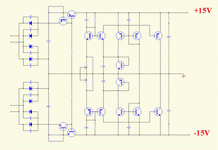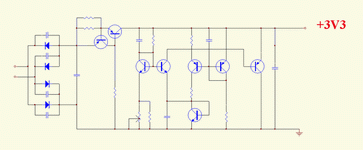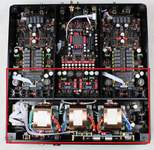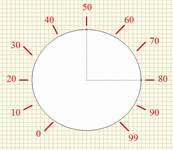|
Detail of the Current Conveyor
(ACSS) Technology
ACSS:
The Reference 10 applied real balanced fully
discrete amp without any OPAs (the OPAs in Reference 10 only for DC
serve) ,without any couple caps ,fully non- feedback . Applies the 4 Pieces Expensive high-end grade PCM1704UK which can support up to
24Bit/96KHz input . Compare to other PCM1704UK designs , we applied Non-feedback ACSS
analog stages. The 4 pcs PCM1704UK feed to the ACSS analog
stages without any OPAs and couple caps so it can avoid sound coloration .
The ACSS is a non-feedback
technology made with fully discrete amplifiers. Most people know the
global
feedback design can offer better specs in test measurements, and
classic non-feedback can't do well in test measurements but can offer better
sound for the human's ears. Here is a conflict of the classic circuits.
But the ACSS opens a new field, it can offer a least coloration sound
which is more neutral with very low distortion and high linearity. So
it can retain the dynamics, detail and neutral sound but not sound
bright or harsh.
D/A:
Applies the 4 Pieces Expensive high-end grade
PCM1704UK . The PCM1704 UK had been consider the best neutral and
"sound like real " DA chips by a lot hififolks, but TI want to
discontinued PCM1704 and increased the price to USD48/pc
, cause the market price increase to USD70/pc .
Output buffer:
The output buffers are Non-feedback. For low impedance, we
applied a diamond output stage which is quite less colored than most
conventional circuits.
The analog part is without couple caps to avoid coloration, and
power supply by four groups class A PSUs.
Applies ACSS technology, even though maybe you only connect to XLR
or RCA output, Reference 10 will always operate in ACSS technology,
and benefit from ACSS technology. Therefore, XLR and RCA output will
also definitely bring about improvement in sound quality. Even
through RCA output, the 4X PCM1704UK DA chips will perform fully.
DSP-1 processor:
Applied the DIR9001 as the SPDIF
interface , even though it only support up to 96KHz /24bit, but its sound characteristic
had been consider most neutral by a lot hifi fans , the jitter only 50PS, much less than the CS8416 ( 200PS
).
DAC Reference 10 has built in DSP-1
processor, which is a Two-channel Digital Interpolation Filter and
data in-phase processor for digital audio. This Device offers
advanced features for high-performance digital signal processing (DSP)
applications up to 250-MHz. Data and Master-clock in-phase
processing are without jitters. So DAC Reference 10 can offer a clear
and focused soundstage, apart from accurate and neutral reproduction
of the recorded disc/music.The DSP-1(V5) digital processor can
supports NOS, 2X, 4X and 8X oversampling customers setting, and keep
the timing more steady.
Theoretically when using the DSP1, data
will be running parallel, achieving near zero jitter state, but
degrade on sound quality not only the jitter, there are some lot
reasons can effect the sound quality, so better source sound better.
But the DSP-1 can process the data better than typical digital
processor chip like PMD-100, DF1704 etc, through some experiment,
although we could perceive the sound quality difference between
differently priced and level of sources , final result shows that using entry level CD
transport or hypermarket grade DVD player, the improvement of sound
quality is huge compared to
PMD-100, DF1704 etc.
Power supply:
Reference
10 applies the excellent
4 pcs PCM1704UK with DSP-1 combo
and excellent analog
output amps, but these are not the only keys of the best sound.
The power supply is most important. Even applying the best DA chip
and the best amp, if matched to a normal power supply, the total
sound may still be average or sound musical, but can't be neutral
and detailed. That is why it is easy to find hi-end grade gears
maybe without the best chips or amp stages, but with plenteous
dedicated DC supply circuits.
The Reference 10 uses
8 groups of high-quality class A parallel
connection PSU , which can
offer very clear DC power for the DAC and amps, producing
a very black background and neutral sound characteristic. The
class A PSU is very important for digital parts. Some designs
may have very low jitter in theory, but if the power is supplied by
a dirty or low-speed power supply, it will increase the jitter and
pollute the data, and degrade the sound quality obviously.
The class A parallel connection PSU has very high input
impedance to avoid pulse through the PSU from affecting the DAC and
low output impedance with very fast speed and high linearity, so it
is a very clean power supply. In my experience, its sound is better
than battery power supply, better human sound and neutral.
The Reference 10 uses three high performance transformers. More than
50,000uf audio grade NOVER capacitors are used to ensure ample and
smooth power feed. A total of 8 groups class A SPUs and 3 groups
linear PSUs are used to purify the power supply. To achieve high
S/N, the control circuit is powered with separate regulator.



Volume
control:
The volume control is also different from conventional
technology. Conventional volume control technology is
the volume control implement in the analog amp
input stage through a volume pot to reduce the signal . The
volume pots quality effect the sound quality direct , the low
quality volume pot cause lost the detail and channels imbalance
cause the soundstage distortion . Even the high
performance volume pot still cause the detail lose. Whatever
quality volume pots, must cause the S/N worst .
But in
the Reference 10.32 , we applied the I/V conversion volume control ,
the volume control just a
variable passive I/V conversion place at the ACSS amp output ,
where the output is the current signal, not the voltage signal. The
volume control is I/V conversion, and the volume depends on the
current (I) conversion to the voltage (V). (Like R-2R D/A chips
output passive I/V conversion)
It can keep the signal frequency band flat and
not lost any detail.
It can't degrade on sound
quality in every volume level . After the volume , there are four
groups
diamond non-feedback buffer output stages offer the
very low output impedance .
Mark Levinson also knows that current volume control has great
benefits, so in their Top End preamp NO.32 volume control, they use
many components to change the signal to current signal (I), then
implement the volume control
, and then change back
to voltage signal (V) again. But Reference 10.32 is simply a more complete
work in terms of the current signal, and technically, it is superior
to conventional technology.
The less conversion bring much neutral sound .
The volume
control quality is much important in the real balance gear . It must guarantee the
four channels signal control exact to achieve the performance of the
real balance gear . If the cool and hot of the balance signal
can't guarantee exact, the balance output will has large distortion
cause the sound quality and performance even much worst than a
single end gear waste the balance gear design and the cost.
In Reference
10.32
is applied a four channels digital control relays based volume
control. .Reference 10.32 has total four channels through changing the
DALE resistors to control the volume for avoid channels
imbalanced ,achieve the best performance and sound quality of
the gear.
Reference 10.32 have 100
steps volume control, control range achieve 90DB (usually the
steps volume ports, potentiometer volume port, relays base
volume control all have around 70DB range ), very smooth
control range on first 50 steps , cooperate with 13DB high gain,
so can very
easy adjust the volume for both high / low sensitivity
headphone and speakers.
While users
change the volume, the different relays break or close, it may had
slightly switch sound on output and disappear while stop change the
volume.
Supper Exponential volume characteristic
The Volume steps comparison to normal volume knob


Shield:
Reference 10 has complete separation of left, right
amplifier channels, power supply, and transformer.
Reference 10 uses heavyweight all-aluminum alloy chassis to prevent the
eddy current of transformers from interfering on circuit board.
Reference
10 applies optical couple isolation for the MCU and the
control implementations to prevent the MCU affecting the audio parts.
Static storage mode control software:
In most control
softwares design, the MCU will continuously output data to the
perform parts , the MCU had the very high speed, so the output data
become high frequency impulses disturb the audio signal circuits
make the sound worst . This product had applied static storage mode
control software , the MCU output once control data and save in the
perform parts while just power on and users operate ,then stop
output data until users next operation. This design make the sound
quality improve on the clear and transparency .
|




